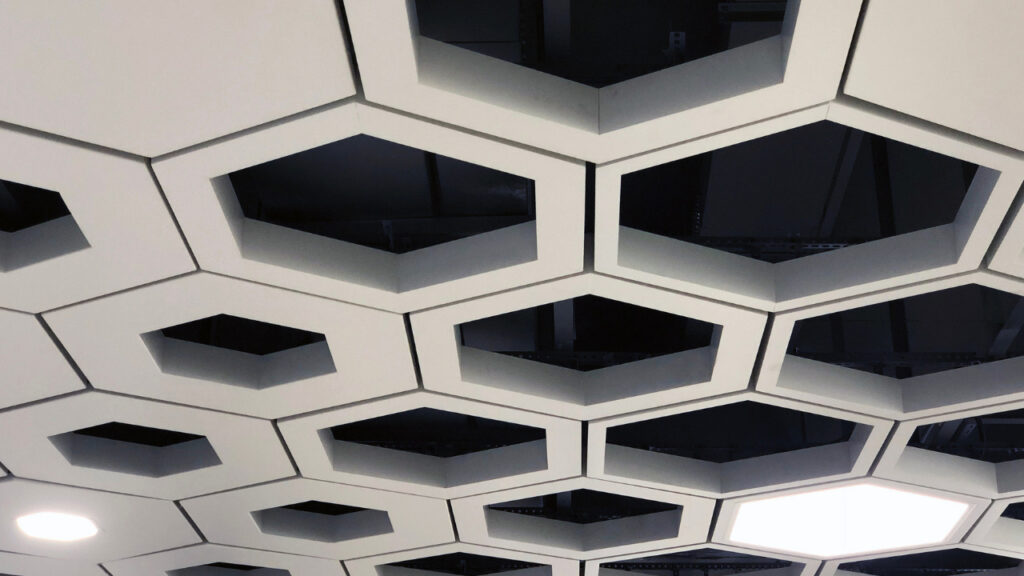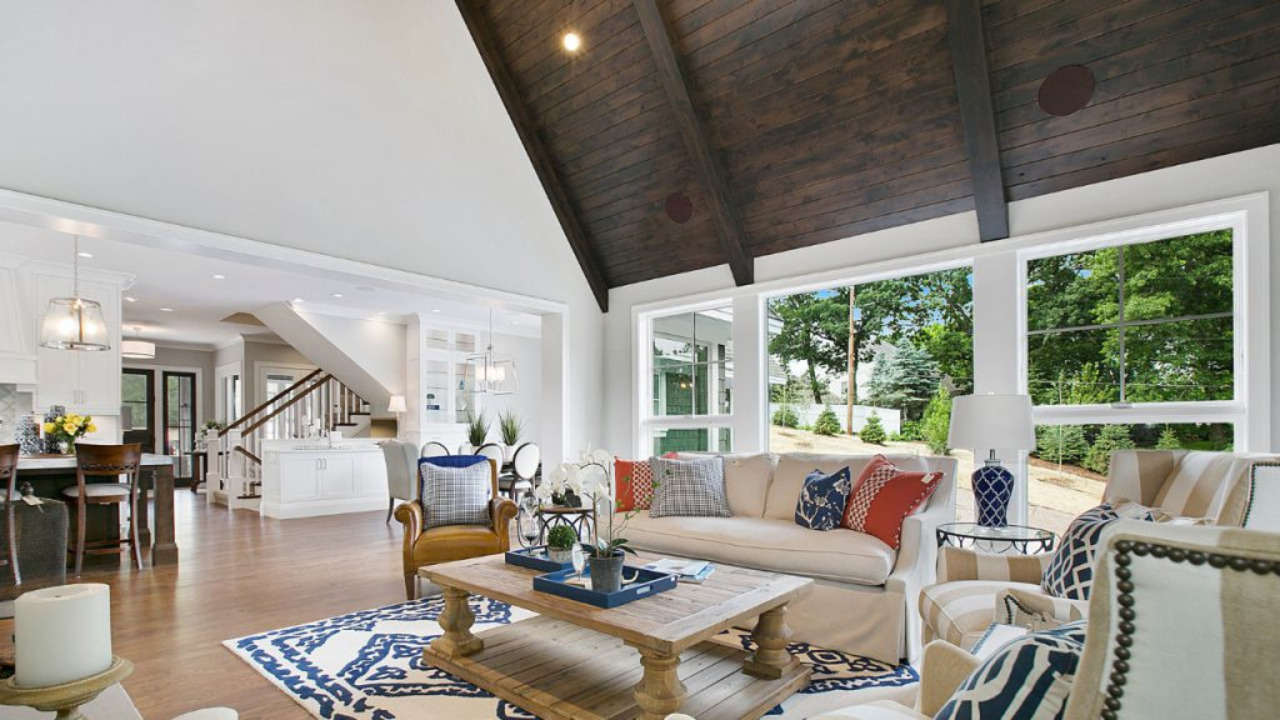Have you ever heard about putting a ceiling over an existing one?
Well, this is possible and such ceilings are known as drop ceilings or suspended ceilings.
No matter if you are looking to replace asbestos popcorn ceilings or want a sound-proofing effect, they can be a top preference. We recognize drop ceilings for their versatility, easy installation and several other properties.
Unlike ancient ceiling types, suspended ceilings come with a modern touch and elevate the interior of the house making it look more sophisticated and trendy. This ceiling is commonly preferable for commercial buildings. However, people also choose them for their house interior.
Let’s talk more on the drop ceilings, their types, purpose and installation.
Table of Contents
What are Drop Ceilings

A drop ceiling, also termed false or suspended ceiling, is a secondary ceiling. This ceiling type is installed underneath the main or structural ceiling and is non-load-bearing. In other words, for aesthetic purposes, ceiling panels are installed below the main ceiling.
Drop ceilings improve the acoustics of a living space, increasing energy efficiency, and are easier to work on when it comes to plumbing issues, HVAC systems installation, electrical wiring, etc. However, drop ceilings, unlike the primary ceilings, don’t carry any load.
History of Drop Ceilings
The history of drop ceilings dates back to the early 20th century. Drop ceilings were invented when architects thought to come up with the options to conceal the ceiling imperfections. So, they came up with this striking idea of disguising ceiling damages using a suspended ) grid-like network.

Initially, for a very long time, drop ceilings were simply plain white panels hung below the main ceiling. The early drop ceilings were used to conceal the structural imperfections. However, with time the focus shifted on utilizing these ceilings to enhance the visual appeal of the building.
5 Types of Drop Ceilings

The following types of drop ceilings are commonly used in contemporary architecture.
1. Gypsum Boards
Also termed drywall or plasterboards, this type of drop ceiling panels installation requires a grid system. They provide a seamless look to the interior and make it elegant, neat and fine-tuned with the surroundings.
Some drywall or plaster boards also have textured imprints on them and might resemble textured ceilings such as a popcorn ceiling.
2. Acoustic Tiles
Acoustic tiles for drop ceilings are especially designed to improve the sound absorption within a building. These tiles are made up of specialized material such as fiberglass. We often see these drop ceilings in commercial buildings such as offices, hospitals, etc. for noise control purposes.
3. PVC Tiles
PVC tiles serve as a great material for drop ceilings. They are lightweight and moisture-resistant.This helps prolong their life and necessitate lesser maintenance. PVC tiles or panels are also durable and different architectural details can be carved onto their surface to provide an intricate style.
4. Wooden Panels
Wooden drop ceilings are all about utilizing the natural beauty of timber for construction works. In this case, wooden panels are fitted into the grid system and the result is a rustic-cum-trendy look. This uplifts your interior even more if your surroundings have a touch of wood in the form of fixtures, furniture, etc.
5. Metal Panels
Metal panels are another type of drop ceiling. These are fitted in the grid system and provide visual appeal to the interior. However, they are less commonly used and found in retail stores, airports, etc.
In addition to the above types, drop ceiling panels are also available in different decorations, some may also have lighting or other unique, imprinted designs. You can even go for a different hue if you want to create a coherent interior.
Benefits of Drop Ceilings
When it comes to drop ceilings, there are many benefits of having. Some of the basic purposes are:
1. Enhancing Aesthetics
These false ceilings can enhance the visual appeal of any space. A variety of design, pattern and color options are available that can be a wonderful addition to your boring space. However, make sure to choose the design carefully. Whatever style or customization you choose should value the interior and should lift it up. Also, it should get along easily with the existing design.
2. Improving Acoustics
If you plan to install false or drop ceilings at your place, you must ensure that the advantage of improved acoustics is rightly availed. The noise attenuation property of these ceilings is an important factor in ranking these ceilings in the list of homeowners’ preferred choices.
3. Conceal HVAC System
One of the major reasons why people prefer drop ceilings is that it can easily conceal the HVAC system, plumbing pipes, and electrical wires etc. This provides a more clean and finished look to your house interior.
4. Moisture Resistance
Another purpose of drop ceilings is their ability to resist the moisture. This property makes them the right choice for places like kitchens, swimming pools, saloons, etc. Moisture resistance also keeps them mold free which is another benefit of having drop ceilings.
5. Thermal Insulation
Thermal insulation is another property of drop ceilings. False ceilings tend to enhance the thermal performance of a space. Suspended ceiling reduces the height of a room and warmer stays in the room. This also reduces the cost of artificially heating the room.
6. Cost Effectiveness
Cost considerations are undoubtedly very important when it comes to drop ceilings. Drop ceilings can save costs in many ways. These ceilings are cost effective as they conceal the damaged ceiling, reduce the heating bills, and can be replaced individually in case of damage.
7. Energy Efficiency
Another striking feature of drop ceilings is that they increase the energy efficiency inside the building. This means that there is less energy wastage and you will require less time to heat or cool your inner surroundings.
Disadvantages of Drop Ceilings
Despite have some really catchy pros, drop ceilings also have some disadvantages:
1. Limited Design Options
The grid pattern and available panel sizes may sometimes limit the design flexibility provided by drop ceilings.
2. Require Periodic Cleaning
Certain types of drop ceilings are dust-catchy. In other words, they require periodic cleaning owing to the material that becomes a magnet when a dust particle comes in proximity to the ceiling surface.
3. Difficult to Integrate
Installed fixtures such as fans, lighting, etc. sometimes pose a difficulty when it comes to integrating them with false ceilings.
Installation of Drop Ceilings

The following steps can serve as a guide for installing drop ceilings in your building.
1. Plan Layout
The first step is to precisely determine the room dimensions and the area the drop ceiling is intended to cover. When planning the layout, consider the items already installed such as ceiling fans, lighting, etc. Mark the level line on surrounding walls to roughly set the depth of suspension or drop height of the false ceiling.
2. Install Grid System
Using the marked line as reference, install the grid system that will carry the drop ceiling. Support the ends of the grid system on a metal wall angle and make sure it is precisely leveled. Secure it using screws or nails. Install the main runners of the grid system already in place. Also secure them by using clips or connectors at regular intervals.
3. Suspend the Grid System
Using hanger wires, suspend the grid system, making it independent of any other support. The hanger wires will connect the false or drop ceiling with the main ceiling. Install measured panels of the ceiling and fit them in the grid system, ensuring a snug fit. Trim the edge of panels if required.
4. Customize Décor
Finally, you can go for customized décor in the form of fixtures, lighting, paint coats, etc.
However, make sure to choose a professional with proven experience for drop ceiling installation.

Cost of Drop Ceilings
Quoting a rough estimate, the total installation cost for a drop ceiling job can range from $3 to $8 per square foot. This is exclusive of any additional customization that you might require.
Many factors have a direct bearing on the cost of drop ceilings. The factors that influence the cost chart include the type of ceiling material, room size, customization, etc.
Suspended Ceiling for A Trendy Interior
Drop ceilings, or false ceiling, refers to the ceiling that hangs below the primary ceiling in a room. This ceiling type is known for its many benefits such as thermal insulation, noise control, better visual appeal etc. These ceilings can be of different types and are suitable with many building interiors.
So, if you are choosing a ceiling type for your modern space, drop ceiling can be the go-to option. However, we recommend you to consult with a professional to choose the right type of drop ceilings for your interior.





